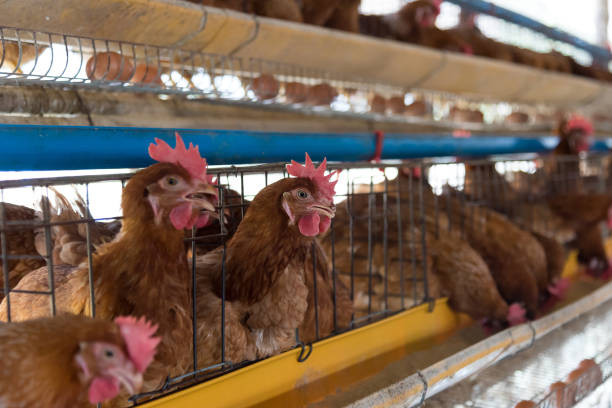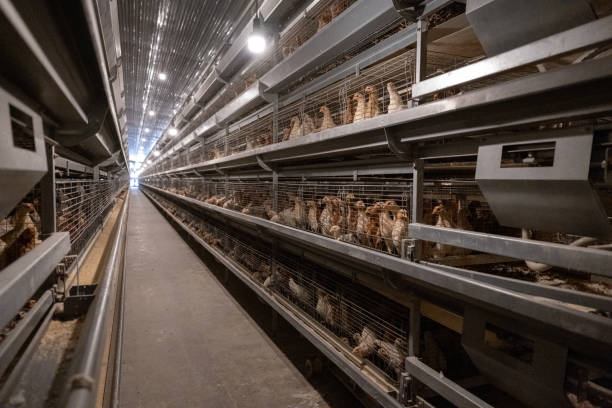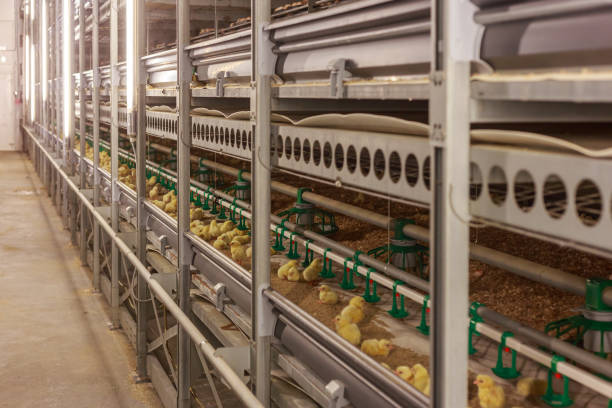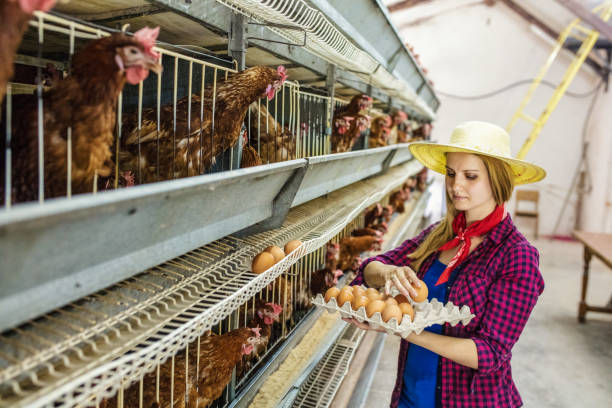
Maximizing Profit: Broiler Chicken Cages for a 10,000-Bird Operation
Maximizing Profit: Broiler Chicken Cages for a 10,000-Bird Operation
For poultry farmers in Africa aiming to scale up and maximize profits, investing in efficient housing solutions is crucial. Broiler chicken cages offer a controlled environment that can significantly enhance productivity, reduce disease, and ultimately boost your bottom line. This article explores the benefits of using broiler chicken cages for a 10,000-bird operation, focusing on key considerations for maximizing profitability. We’ll delve into cage types, space requirements, feeding and watering systems, waste management, and overall operational strategies to ensure your farm operates at peak efficiency.
The Advantages of Broiler Chicken Cages
Before diving into the specifics of a 10,000-bird operation, let’s highlight the core advantages of using broiler chicken cages:
Improved Land Utilization: Cages allow for higher stocking densities compared to traditional floor systems. This means you can raise more birds in the same amount of space, making efficient use of your land. For a 10,000-bird operation, this is particularly important as land costs can be a significant factor.
Enhanced Disease Control: Cages separate birds from their droppings, significantly reducing the risk of coccidiosis and other common poultry diseases. This leads to lower mortality rates and reduced medication costs, contributing directly to increased profitability. The controlled environment makes it easier to monitor bird health and implement targeted interventions.
Better Feed Conversion Ratio (FCR): Caged systems provide better control over feed distribution, minimizing wastage. Birds have easier access to feed and water, leading to improved FCR and reduced feed costs, which is often the biggest operational expense in broiler farming. Precise feeding strategies can be implemented based on the age and weight of the birds.
Reduced Labor Costs: Automated feeding and watering systems, coupled with efficient waste removal, reduce the need for manual labor. This translates into lower labor costs and allows you to focus on other critical aspects of farm management. In areas where labor is scarce or expensive, this is a significant advantage.
Uniform Growth: Cages provide a more controlled environment, minimizing competition for resources and ensuring more uniform growth rates. This leads to a more consistent product, which is highly desirable for processors and consumers. Uniformity simplifies harvesting and processing, streamlining the entire operation.
Easier Monitoring and Management: The confined nature of cages makes it easier to monitor individual bird health and identify potential problems early on. This allows for quicker intervention and prevents widespread disease outbreaks. Management practices, such as vaccination and medication, can be implemented more efficiently.
Choosing the Right Broiler Chicken Cage System
Selecting the appropriate cage system is crucial for a successful 10,000-bird operation. Several factors should be considered:
Cage Type:
Tiered Systems (A-frame or H-frame): These systems maximize vertical space, allowing for the highest stocking densities. H-frame systems are generally more robust and easier to automate, making them ideal for larger operations. A-frame systems are often more cost-effective for smaller to medium-sized farms.
Flat Deck Cages: These are single-level cages that are typically used for smaller-scale operations or in situations where ceiling height is limited. They offer easier access to the birds but require more floor space per bird.
Material: Galvanized steel cages are the most common choice due to their durability, resistance to corrosion, and ease of cleaning. Hot-dip galvanized cages offer superior protection compared to electro-galvanized cages and are recommended for long-term use.
Cage Size and Layout: The size of the cages should be appropriate for the breed of broiler chickens you are raising and the desired stocking density. Ensure adequate space for birds to move comfortably and access feed and water. The layout of the cages should facilitate easy access for feeding, watering, and waste removal.
Space Requirements for a 10,000-Bird Operation
Determining the appropriate space requirements is essential for maximizing productivity and ensuring bird welfare. Stocking density should be carefully considered and adhere to local regulations and best practices.
Cage Dimensions and Bird Density: Generally, a good rule of thumb is to allow approximately 450-500 square centimeters of floor space per bird. This will vary slightly depending on the breed and expected market weight. For a 10,000-bird operation, this translates to roughly 45-50 square meters of cage floor space. When calculating the total area required, remember to factor in walkways, feed storage, and other necessities.
House Size: Based on the cage floor space and incorporating walkways and service areas, a poultry house for a 10,000-bird operation using cages would typically range from 60 to 80 square meters. The height of the house should be sufficient to accommodate the cage system, considering multiple tiers in tiered systems, and allow for proper ventilation.
Feeding and Watering Systems
Efficient feeding and watering systems are critical for optimal growth and FCR.
Automatic Feeding Systems: Automatic feeding systems distribute feed evenly throughout the cages, reducing wastage and ensuring all birds have access to adequate nutrition. Chain feeding systems are a popular choice for broiler cages due to their reliability and ability to deliver a consistent amount of feed. Auger systems can also be used, particularly for larger operations.
Nipple Drinkers: Nipple drinkers provide a clean and hygienic water source for broilers. They minimize water wastage and reduce the risk of contamination. Ensure the drinkers are appropriately sized and positioned for the age of the birds. The number of drinkers should be sufficient to meet the birds’ water requirements, especially during hot weather.
Water Storage and Filtration: Adequate water storage capacity is essential to ensure a continuous water supply, even during periods of drought or water shortages. A water filtration system is crucial to remove impurities and maintain the quality of the drinking water. Regular cleaning and maintenance of the water system are necessary to prevent the build-up of biofilms and bacteria.

Effective waste management is crucial for maintaining a healthy environment and preventing the spread of disease.
Manure Removal Systems: Depending on the cage system, manure can be removed manually or automatically. Automatic manure removal systems, such as belt systems, significantly reduce labor costs and improve hygiene. The frequency of manure removal depends on the stocking density and the type of system used.
Composting and Biogas Production: Manure can be composted and used as a valuable fertilizer for crop production. Alternatively, it can be used in biogas digesters to produce renewable energy. These sustainable waste management practices can reduce environmental impact and generate additional revenue.
Ventilation and Climate Control
Proper ventilation is essential for maintaining air quality, controlling temperature, and removing excess moisture.
Natural Ventilation: Natural ventilation relies on natural airflow to exchange air in the poultry house. This requires strategically placed openings and proper orientation of the house to prevailing winds. Natural ventilation can be effective in moderate climates but may not be sufficient in hot or humid regions.
Forced Ventilation: Forced ventilation uses fans to circulate air and control temperature. Exhaust fans remove stale air, while inlet fans bring in fresh air. The fan capacity should be sufficient to provide adequate air exchange rates, particularly during hot weather. A combination of natural and forced ventilation can be the most effective solution in many climates. Evaporative cooling systems can be used to further reduce temperatures in hot and dry regions.
Temperature Control: Maintaining optimal temperatures is crucial for broiler growth and performance. Broilers are particularly sensitive to temperature fluctuations, especially during the first few weeks of life. Heating systems may be necessary during cold weather, particularly in areas with harsh winters. Automated climate control systems can monitor temperature and humidity levels and adjust ventilation and heating systems accordingly, ensuring optimal conditions for bird growth.
Lighting
Lighting plays a vital role in broiler growth and development.
Lighting Programs: Broilers typically require a controlled lighting program to optimize growth and feed conversion. Intermittent lighting programs, where periods of light are alternated with periods of darkness, have been shown to improve performance. The intensity and duration of light should be carefully controlled to prevent stress and promote growth. Consult with a poultry expert to develop a lighting program that is appropriate for your specific operation.
LED Lighting: LED lights are energy-efficient and have a long lifespan, making them a cost-effective choice for poultry houses. They also produce less heat compared to traditional incandescent bulbs, reducing the need for cooling. Choose LED lights with a color spectrum that is suitable for poultry production.
Operational Strategies for Maximizing Profit
Beyond the physical infrastructure, several operational strategies are crucial for maximizing profit in a 10,000-bird broiler operation:
Biosecurity Measures: Implement strict biosecurity measures to prevent the introduction and spread of disease. This includes controlling access to the farm, disinfecting equipment, and providing clean clothing and footwear for visitors. A robust biosecurity plan is essential for protecting your investment.
Feed Management: Use high-quality feed that is formulated to meet the nutritional requirements of broilers at different stages of growth. Monitor feed intake and adjust feed formulations as needed. Proper feed management is crucial for achieving optimal growth rates and FCR.
Health Monitoring: Regularly monitor the health of your birds and consult with a veterinarian if you notice any signs of illness. Early detection and treatment of diseases can prevent significant losses. A proactive health management program is essential for maintaining a healthy flock.
Record Keeping: Maintain accurate records of feed consumption, water usage, mortality rates, and other key performance indicators. This data can be used to identify areas for improvement and optimize your management practices.
Marketing and Sales: Develop a marketing plan to ensure you can sell your broilers at a profitable price. This may involve establishing relationships with processors, retailers, or consumers. Consider value-added products, such as pre-cut chicken or marinated chicken, to increase your profit margins.
Investing in broiler chicken cages for a 10,000-bird operation can significantly improve productivity, reduce disease, and boost profitability. Choosing the right cage system, implementing effective feeding and watering systems, managing waste properly, and adhering to strict biosecurity measures are all essential for success. By adopting sound operational strategies and continuously monitoring performance, poultry farmers in Africa can maximize their returns and build a thriving broiler business. Remember to consult with poultry experts and adapt these guidelines to your specific circumstances and local conditions for optimal results. The key is a combination of the right equipment and the right management practices.


